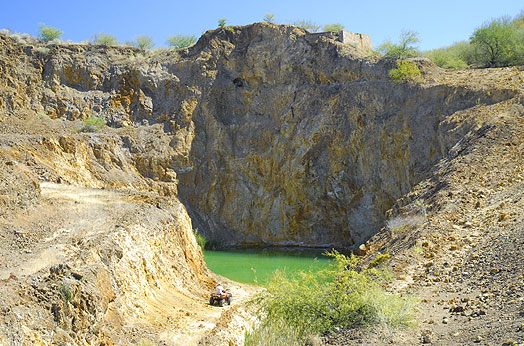For the second time this month Agnico-Eagle Mines (AEM-T, AEM-N) has taken a strategic stake in a junior exploration company with promising assets.
President and chief executive Sean Boyd said the $4.75 million investment in Kootenay Silver (KTN-V) announced earlier today is consistent with his management team’s desire to beef up the company’s presence in Mexico’s Sonora state.
Kootenay Silver’s flagship asset is the past-producing Promontorio project, a diatreme breccia-hosted epithermal silver, lead, zinc and gold deposit about 165 km south of Hermosillo. (Earlier this month, Agnico took a $24 million stake in Sulliden Gold (AUE-T, SDDF-O) and its Shahuindo project in northern Peru.)
The Promontorio project lies in the southwestern part of Sonora within the western basin-and-range province of the Cordillera of Mexico, immediately west of the western boundary of the Sierra Madre Occidental volcanic province.
“Agnico quite likes Sonora and we’ve advanced the Promontorio project significantly over the last 18 months, recognizing it was a large diatreme-hosted complex and that multiple targets exist there,” Kootenay Silver president and chief executive James McDonald told The Northern Miner. (Agnico-Eagle’s La India project is 105 km to the northeast of Promontorio and its Pinos Altos mine is 130 km to the east.)
Promontorio is part of an 80,000-hectare land package that has a number of other mineral systems separate from the Promontorio diatreme, McDonald continues. And elsewhere in Sonora the company has internally generated a number of other grassroots projects.
“Agnico sees value in our ability to make discoveries, advance Promontorio and generate brand-new projects,” McDonald says.
Earlier this month Kootenay announced that it will update Promontorio’s resource estimate by including gold assay results following metallurgical testing that showed up to 94.5% recoveries of gold from pyrite concentrates using a post pressure oxidation treatment process.
The new resource estimate should be completed within the next three weeks.
In the meantime, Promontorio’s open-pit measured and indicated resource currently stands at 36.10 million tonnes grading 31.18 grams silver, 0.45% lead and 0.53% zinc, with inferred resources of 6.63 million tonnes grading 28.32 grams silver, 0.32% lead and 0.39% zinc.
Underground resources in the indicated category tally 1.41 million tonnes of 30.15 grams silver, 0.43% lead and 0.48% zinc and inferred resources add 3.08 million tonnes grading 35.94 grams silver, 0.45% lead and 0.43% zinc.
McDonald notes that the recognition that Promontorio was hosted in a large diatreme complex changed the scope of what the company was looking at. “They [diatremes] can be very productive, they can be multiple, they can be very large, so the geological environment is conducive to large deposits and a good environment to be looking in,” he says.
“The thing about diatreme-hosted systems is that they are large explosive events that have the potential to deposit a lot of metal and they reoccur,” he explains. “The system will explode, collapse, seal, and then explode again, so as a result when you’re in a diatreme system you have the potential for very large deposits like Penasquito and multiple deposits like Cripple Creek in Colorado, where you had a long mining history and then even after that, major discoveries were still being made as recently as just over a decade ago by Anglo.”
McDonald says they knew from the first drilling that they had mineralized breccias “but the geology was pretty complex.”
“You had a large alteration imprint masking rock types, you also had breccia rocks from volcanics, sediments and conglomerates and several types of diatreme breccia and sediments … so it took us a while to recognize we were in a diatreme complex because we were literally in it for the whole time,” McDonald says, likening it to being in a forest and not being able to see the forest for the trees. “Until you get outside of it, it’s hard to recognize what you’re dealing with.”
The light came on last year when the resource was updated and the geological team went through and re-logged thousands of metres of core and then built a geologic model.
McDonald notes that Agnico-Eagle started its due diligence on Kootenay Silver several months ago. Under the non-brokered private placement, Agnico-Eagle has subscribed for 6.25 million units of Kootenay Silver at a price of 76¢ per unit for a 9.96% stake in the junior.
Each unit is made up of one common share of Kootenay and one-half of one common share purchase warrant. The warrants entitle the holder to acquire one common share of Kootenay at a price of $1.08 for two years after the transaction closes.
And at a time when sour markets are making it tough for junior companies to advance projects, the Agnico-Eagle investment is beneficial on several levels.
“It removes a big question mark for the shareholders about where the next funds to get to the next stage are going to come from,” McDonald notes, “and it aligns us with a very strong shareholder with tremendous technical expertise and experience in Mexico.”
News of the investment sent shares of Kootenay Silver up 5.6% or 4¢ to 75¢ a share. Over the last year the junior has traded in a range of 62¢ -$1.25.
Other companies operating in Sonora include Argonaut Gold (AR-T) with its La Colorado project 115 km to the northwest of Promontorio and Alamos Gold (AGI-T, AGI-N) and its Mulatos mine 110 km to the northeast.


Be the first to comment on "Agnico buys into Kootenay"